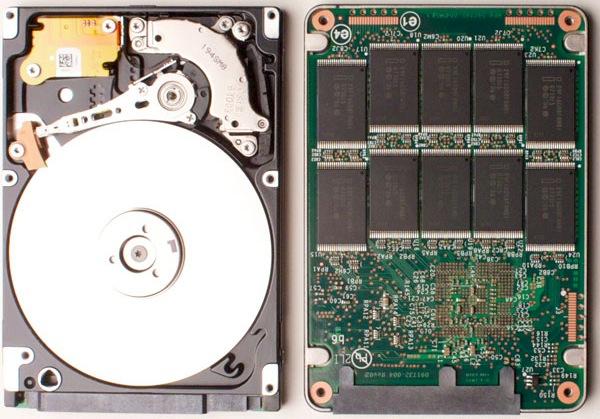Hard Drives: Mechanical v. Solid State v. Hybrid

Hard – Disk Drive, HDD
Hard Disk Drives are the mostly commonly used data storage drives, because of their legacy as being among the first successful models alongside computer development. HDDs are often referred to as mechanical disk drives because of their composition of moving parts. Inside a HDD there are rotating magnetic disks with read and writer heads that are capable of interacting with the data. Data on a Hard Disk Drive can be written, over written, and read until the magnetic disks are damaged or one of the heads is broken. HDDs are ideal for storage purposes and provide a decent performance for an average day-to-day computer user. Most home computers have standard Hard Disk Drives installed from the factory.
Current Hard Disk Drives reach up to 4 Terabyte [ 1 Terabyte = 1000 Gigabytes] of memory, by standards, and are still improving. The main issue with HDDs is creating a disk that holds more memory and will not shatter under high rotating velocity, in order to provide reasonable performance speeds. The price is fairly practical, where $1.00 provides about 12 Gigabytes.
Solid – State Drive, SSD
Solid State Drives are a newer form of a data storage device that does not use movable, mechanical components like a HDD. Instead, SSDs use NAND flash memory, a technique in which data is written electronically onto special memory chips. SSDs are ideal for users who want a computer that has an excellent performance rating. A major problem with SSDs is that they have a finite number of data rewrites available. Overtime, some chips on the drive wear out and the user can simply replace the chip and regain the data. Solid State Drives are much more expensive than Hard Disk Drives, but are a good investment for frequent computer users, who look for performance.
Current Solid State Drives are still being perfected. A SSD is nearly 10 times the expense of a HDD. The capacity of SSDs is limited to 256 Gigabyte standards, because the cost of 1 Gigabyte ranges from $.70 to $1.00 depending of the validity of the manufacturer.
An ideal computer, by today’s standards, would utilize both HDDs and SDDs. A computer would have the operating system and frequently used application installed on the Solid State Drive. While all other data, such as music and documents, would be stored on a Hard Disk Drive. This is the most recommended computer build and set up for experienced computer users, who are not yet convinced that current Hybrid Hard Drives are a worthy investment.
Hybrid
Hybrid Hard Drives are a combination of Hard Disk Drives and Solid State Drives in one drive. A Hybrid’s composition includes the rotating magnetic disk of a HDD and a small amount of NAND flash memory. The Hybrid drive monitors the data being used and stored, then places the most frequent used data on the flash memory and the stored data on the magnetic disk. This allows for a hard drive that performs as a SSD, but is capable of the data storing capacity of a HDD.
The cost of Hybrid Hard Drives is slightly higher than for HDDs. The technology is ideal in use, but requires further work before it may become utilized as a practical disk drive for an average consumer.
Some recommended websites to check out technology reviews and compare prices are:
NewEgg.com
TigerDirect.com
